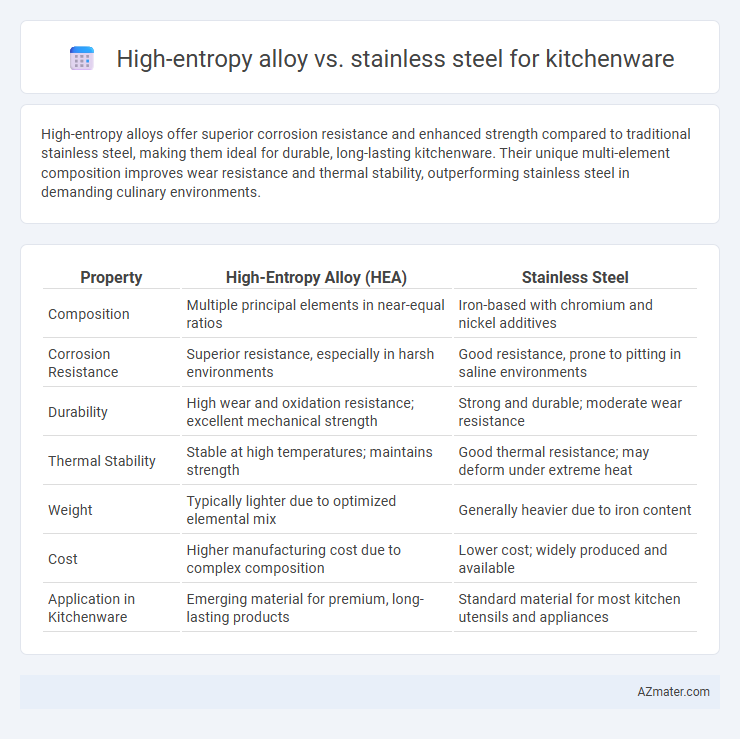High-entropy alloys offer superior corrosion resistance and enhanced strength compared to traditional stainless steel, making them ideal for durable, long-lasting kitchenware. Their unique multi-element composition improves wear resistance and thermal stability, outperforming stainless steel in demanding culinary environments.
Table of Comparison
| Property | High-Entropy Alloy (HEA) | Stainless Steel |
|---|---|---|
| Composition | Multiple principal elements in near-equal ratios | Iron-based with chromium and nickel additives |
| Corrosion Resistance | Superior resistance, especially in harsh environments | Good resistance, prone to pitting in saline environments |
| Durability | High wear and oxidation resistance; excellent mechanical strength | Strong and durable; moderate wear resistance |
| Thermal Stability | Stable at high temperatures; maintains strength | Good thermal resistance; may deform under extreme heat |
| Weight | Typically lighter due to optimized elemental mix | Generally heavier due to iron content |
| Cost | Higher manufacturing cost due to complex composition | Lower cost; widely produced and available |
| Application in Kitchenware | Emerging material for premium, long-lasting products | Standard material for most kitchen utensils and appliances |
Introduction to High-Entropy Alloy vs Stainless Steel Kitchenware
High-entropy alloys (HEAs) are advanced materials composed of five or more principal elements mixed in near-equal proportions, offering exceptional strength, corrosion resistance, and thermal stability compared to traditional stainless steel. Stainless steel, primarily an iron-based alloy with chromium, nickel, and carbon, is widely used in kitchenware due to its durability, corrosion resistance, and affordability. High-entropy alloy kitchenware demonstrates enhanced mechanical properties and longevity, making it a promising alternative to conventional stainless steel for high-performance culinary applications.
Material Composition and Structure Differences
High-entropy alloys (HEAs) consist of five or more principal elements mixed in near-equal atomic percentages, creating a complex, multi-element matrix with high configurational entropy, whereas stainless steel primarily combines iron with chromium and nickel to form a simpler, well-understood alloy system. The unique equiatomic or near-equiatomic composition of HEAs leads to a stable, single-phase solid solution structure with exceptional mechanical strength and corrosion resistance, contrasting with the multiphase microstructure of stainless steel that includes ferrite, austenite, or martensite depending on the grade. These fundamental differences in material composition and microstructure result in HEAs offering potentially enhanced durability and chemical stability for kitchenware applications compared to conventional stainless steel.
Mechanical Strength and Durability Comparison
High-entropy alloys (HEAs) exhibit superior mechanical strength and exceptional resistance to wear and deformation compared to traditional stainless steel, making them highly durable for kitchenware applications. The complex multi-element composition of HEAs enhances hardness and corrosion resistance, outperforming the common 304 and 316 stainless steel grades. This increased durability ensures longer lifespan and better performance under thermal and mechanical stress typical in cooking environments.
Corrosion and Rust Resistance: Which Performs Better?
High-entropy alloys exhibit superior corrosion and rust resistance compared to traditional stainless steel due to their multi-element composition, which forms a stable and protective oxide layer. This enhanced stability under various environmental conditions makes high-entropy alloys particularly effective against pitting and crevice corrosion often seen in kitchenware. Stainless steel, especially grades like 304 and 316, also provide good corrosion resistance but can be more susceptible to localized corrosion over time.
Thermal Conductivity and Heat Distribution
High-entropy alloys (HEAs) exhibit lower thermal conductivity compared to traditional stainless steel, resulting in slower heat transfer during cooking applications. Stainless steel's higher thermal conductivity ensures more uniform and rapid heat distribution across kitchenware surfaces, promoting efficient cooking performance. While HEAs offer enhanced strength and corrosion resistance, stainless steel remains superior for heat management in culinary tools due to its optimized thermal properties.
Non-Stick and Food Safety Properties
High-entropy alloys (HEAs) exhibit superior corrosion resistance and non-stick properties compared to traditional stainless steel, enhancing food safety by minimizing metal ion leaching during cooking. The complex, multi-element composition of HEAs creates a stable oxide layer that prevents bacterial growth and reduces allergenic reactions, making them an excellent choice for kitchenware. Stainless steel, while durable, often requires additional coatings to achieve non-stick performance and can pose risks of nickel and chromium exposure during prolonged use.
Cost and Availability for Kitchenware Applications
High-entropy alloys (HEAs) typically cost significantly more than stainless steel due to complex production processes and limited commercial availability, making them less accessible for widespread kitchenware applications. Stainless steel remains the industry standard for kitchenware because of its cost-effectiveness, abundance, and well-established manufacturing infrastructure. While HEAs offer superior mechanical properties and corrosion resistance, their higher price and scarcity limit their practical use compared to readily available stainless steel grades like 304 and 316.
Environmental Impact and Sustainability
High-entropy alloys (HEAs) offer superior corrosion resistance and durability compared to traditional stainless steel, reducing the frequency of replacement and minimizing waste in kitchenware applications. The production of HEAs often involves more energy-intensive processes and rare elements, which can increase their initial environmental footprint relative to stainless steel. However, their extended lifecycle and potential for recyclability contribute to improved sustainability in long-term use, offsetting higher production impacts.
User Experience: Handling, Weight, and Aesthetics
High-entropy alloys (HEAs) provide a unique balance of lightweight properties and exceptional strength, making kitchenware easier to handle and reducing fatigue during prolonged use. Stainless steel, known for its durability and classic polished look, is heavier but offers a familiar aesthetic that appeals to traditional kitchen users. The modern, often matte or subtly textured finishes of HEAs enhance visual appeal while improving grip, contrasting with the smooth, reflective surfaces typical of stainless steel cookware.
Future Trends in Kitchenware Material Innovation
High-entropy alloys (HEAs) are emerging as revolutionary materials in kitchenware due to their exceptional corrosion resistance, mechanical strength, and thermal stability compared to traditional stainless steel. Innovations in HEA compositions, such as incorporating elements like cobalt, nickel, and chromium, promise enhanced durability and non-reactivity for cookware exposed to high temperatures and acidic environments. Future trends point to HEAs enabling lighter, longer-lasting kitchenware with superior resistance to wear and microbial corrosion, potentially surpassing stainless steel as the industry standard.

Infographic: High-entropy alloy vs Stainless steel for Kitchenware
 azmater.com
azmater.com